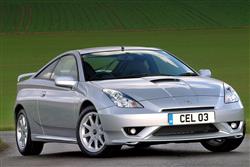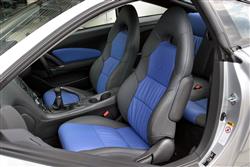GENERATION NEXT (some text hidden) --NONE--
BY ANDY ENRIGHT
Introductionword count: 122
Look back over the previous iterations of the Toyota Celica and it's easy to pick out the highs and lows. The fourth generation ST165 (1985-1990), brought Toyota into world rallying with the GT4, the fifth generation Celica ST185 (1990-1994) had odd looks but was otherwise the best of the 'old' bunch. The sixth generation ST205 (1994-1999) was a bit chubby and overblown. This latest seventh generation Celica goes back to what made the Celica name popular in the first place, namely light weight and razor sharp reflexes. Although notions of practicality sometimes take a cramped back seat when buying a used sports coupe, Toyota's reliability record and engineering qualities help to keep the Celica near the top of most buyer's wish lists.
Modelsword count: 9
Models Covered: (3 dr coupe 1.8 petrol [VVTi, 190])
Historyword count: 372
The development of the seventh generation Celica followed a standard path. Starting from an unsophisticated yet enjoyable original, Toyota built generation after generation of cars, gradually going further upmarket and getting heavier and more powerful. The ST185 series probably marked the Celica's competition zenith, winning two World Rally Championships in 1993 and 1994, but the follow up car was viewed by many as a disappointment, taking the sporty Celica into lazy cruising territory. The same was indeed said of Toyota's MR2 range, being developed in parallel. The design team at Toyota's Calty Research division in California looked at this philosophy and went to work with the red pen on it. Espousing a doctrine of light weight, edgy styling and a wheel at each corner for exceptional agility, the seventh generation Celica looked a winner before it ever turned a wheel, and crowds at the 1999 Frankfurt Motor Show realised that Toyota was onto something. With only 140bhp from the VVT-i engine, it wasn't a fire breathing super coupe but nevertheless the pared down approach promised driver satisfaction, and so it proved. So good was the Celica's chassis that it was an open secret that a more powerful model was being developed. Rather than unleash a turbocharged, four-wheel drive GT4 version, as it had with the three previous Celicas, Toyota instead did something of a Honda. The Celica 190 offered variable valve timing and variable valve lift to punch out 190bhp at a dizzying 6800rpm. Were it a Honda model, it would undoubtedly have worn a Type-R badge, but the latest Celica merely sported a tiny red badge on its angular rump to differentiate it. With a specific output of 106.7bhp per litre, the Celica 190's credentials as a masterpiece of the engine making art were put into perspective compared to the McLaren F1 (103.3bhp/litre) and the BMW M3 (106bhp/litre). The round of price-cutting that took place in 2000 made the two Celica models great value for money, although used values took a while to reflect this. Helping to restore profit margins was the Celica T-Sport, a model launched in 2001 which was mechanically similar to the Celica 190 but commanded a £3,000 price premium for a bodykit, leather interior and other accoutrements.
What You Getword count: 311
Standard equipment includes twin front and side airbags, ABS, a leather-covered steering wheel, electric windows and mirrors, a decent stereo, 16'' alloy wheels and remote central locking. If you want more, a temptingly priced 'Premium Pack' (standard in the Celica 190) adds leather, a power sunroof and climate control. Alternatively, there's a 'Sports Pack' with bigger 17'' alloys and a spoiler. The T-Sport gets a set of cracking 17-inch alloy wheels plus a deeper front spoiler than that worn by the Celica 190, and interior upgrades that include leather seats and a CD autochanger. Inside, there's not much to offend - unless you have a particular aversion to black and grey plastic or orange instrument dials. The three-spoke wheel feels good to hold and the 'drilled' metal pedals lend a sporty, purposeful touch. Despite the extra cabin space boasted by the latest model, don't expect this car to be any more than a 2+2. Though there's enough legroom for a couple of adults to sit in the back, headroom is at more of a premium. Having said that, the given space is a lot less cramped than that offered by many coupe rivals. We could go on to talk about split-folding rear seats and useful luggage space but we'd be in danger of coming over all practical - which would defeat the point of the premise we began with. If you don't like the look of this latest Celica, then you won't buy it and no amount of talk on fuel consumption, cabin space and low running costs will change your mind. Fortunately for Toyota, aesthetic objections are unlikely. The more you admire the clean, distinctive lines, the more details you find to appreciate: the tiny front grille, the Ferrari-like bonnet scoop and the beautifully sculpted front and rear lights. All speak of a design team that cared about their creation.
To see the full road test text contact us on 0330 0020 227
Pictures (high res disabled)
.jpg)
.jpg)
|
.jpg)
|
.jpg)
| |||

|

|
Scoring (subset of scores)
Category: Coupes
| Performance | |
| Handling | |
| Comfort | |
| Space | |
| Styling, Build, Value, Equipment, Depreciation, Handling, Insurance and Total scores are available with our full data feed. | |



